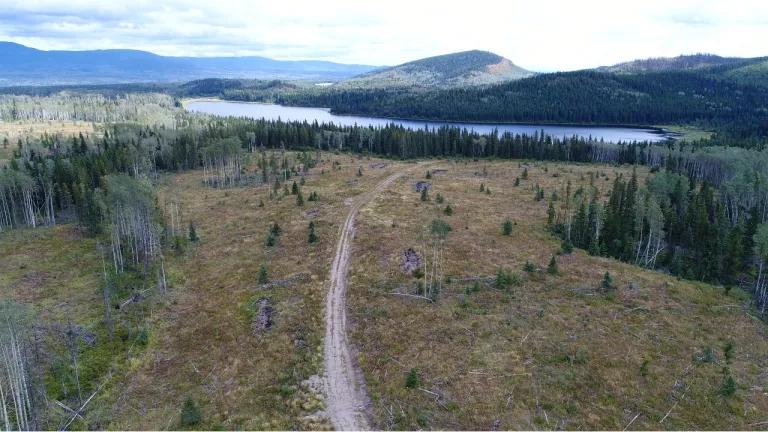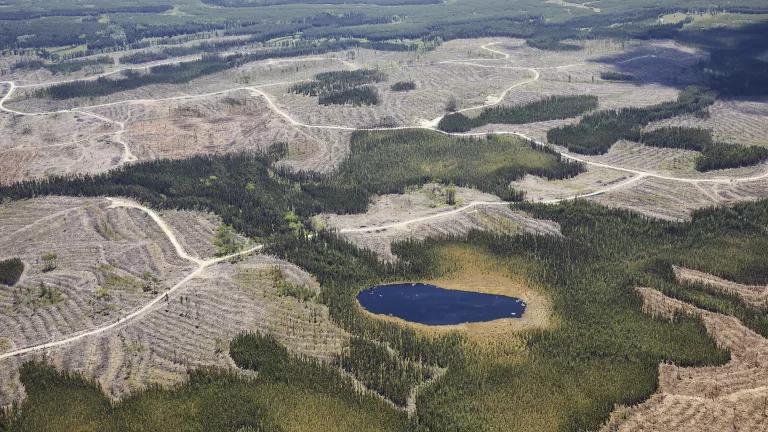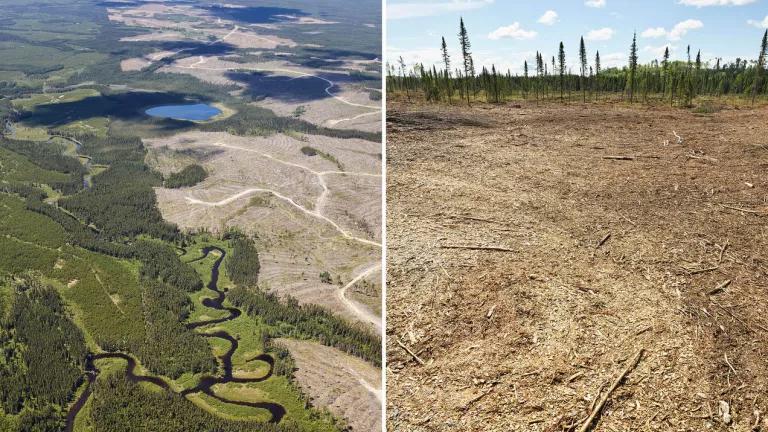
Forest clearcut by Drax near Topley, British Columbia
Conservation North/Kai Nagata
Predictions regarding climate change and biodiversity loss are becoming increasingly dire. Scientists have found that, without rapid and significant measures to abate global greenhouse gas emissions, planetary warming is likely to reach 1.5 degrees Celsius between 2030 and 2052. One million species, meanwhile, are threatened with extinction, due foremost to habitat destruction.
The good news is that an increasing number of countries have recognized that protecting our planet’s forests is absolutely critical to combating both climate disaster and massive biodiversity loss. Parties to the Convention on Biological Diversity recently committed to protecting 30 percent of their lands and seas by 2030. And more than 100 countries signed the Glasgow Declaration on Forests and Land Use at COP26, committing to addressing deforestation and land degradation, and recognizing that Indigenous and community rights are critical to addressing forest loss.
The bad news is that a huge obstacle remains to these commitments: a colossal lack of leadership on forest protection from Global North countries, which have directed attention to tropical deforestation while ignoring its own role in eroding the world’s forests. Take the Glasgow Declaration: In the year following its signing, Global North signatories have almost exclusively focused on measures addressing tropical deforestation, ignoring the framework’s inclusion of halting degradation occurring in their own countries.
Global North countries have ensured they can go on logging their forests—while greater limits are placed on logging in the Global South—by centering policies around “deforestation” and “forest loss,” defined narrowly to apply only to industrial practices that actually convert forest to other land use entirely (e.g., palm oil plantation) and not damaging practices like clearcutting that are commonplace in Northern Hemisphere forests. As my colleague Jen Skene wrote, “[t]he result is an international policy dynamic that fails to hold countries…accountable for the clearcutting of boreal and temperate forests, which are some of the most carbon-dense forests in the world, and under severe threat from industry. While all eyes are on the tropics, the first- and third-highest intact forest loss in the world is happening in Russia and Canada, respectively—both predominantly boreal regions.”
NRDC is tackling this lack of responsibility from the Global North on multiple fronts. We’re fighting to stop the United Kingdom and European Union from subsidizing and relying on bioenergy—energy produced by burning wood pellets made from trees—to meet their climate goals. Bioenergy is a disaster for both the climate and our planet’s forests because it clearcuts forests across the globe (including in the United States and Canada) that sequester massive amounts of carbon and provide habitat for thousands of species.
We’re also working to stop forest degradation in the Canadian boreal, where unsustainable industrial logging is driving the loss of some of the world’s most climate-critical forests. Canada has the third-highest intact forest loss in the world, behind only Russia and Brazil. Each year, Canada’s logging industry clearcuts more than one million acres of the boreal, much of this in irreplaceable primary forests, driving devastating climate and species impacts. More than 80% of forest product exports from Canada end up in the U.S. marketplace, where much of them meet a fate in our toilet bowls and trash cans.
Our advocacy also focuses on U.S. forests, where we’re fighting for protections in the conterminous United States and Alaska. Just last month, we celebrated a big win after the Biden Administration reinstated Roadless Rule protections for more than nine million acres in the Tongass National Forest in Alaska, a decades-long effort NRDC has been working towards. President Biden also issued a critical executive order on Earth Day of 2022, directing federal agencies to define and design conservation measures for mature and old growth forests on public lands. As we approach the one-year anniversary of this executive order, we are continuing to pressure the administration and agencies to follow through on these promises by protecting mature and old growth trees and forests from unnecessary logging on federal forests nationwide.
Despite the United States’ opposition to deforestation in many corners of the globe, a litany of damaging logging projects exist on federal lands that put hundreds of thousands of acres of mature and old growth trees and forests on the chopping block, while less than five percent of total U.S. timber supply comes from federal forest lands. At this critical point in our planet’s climate story, protecting these carbon-storage champions and pillars of ecological biodiversity is a low-cost, immediately implementable natural climate solution to fight climate change and protect our global ecosystem.
On the International Day of Forests, the message is simple: To save our planet, we must save our forests. But to do so, the Global North must leave its own trees standing.




